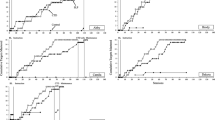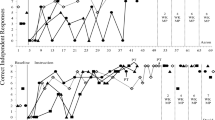Abstract
We compared the effects of two instructional strategies on the frequency of errors and episodes of disruptive behavior of 4 students with autism. In Phase I, easy and difficult tasks were presented to determine whether the tasks were associated with differential rates of disruptive behavior. Phase II compared the effects of a least-to-most prompting procedure (LTM) to a progressive time delay procedure (PTD) on errors and disruptive behavior when difficult tasks were presented. Observers sequentially recorded instructor instructions, response prompts, prompts for appropriate sitting, and feedback statements; and student disruptive, correct, error, and no responses during 1:1 sessions. Results showed PTD produced fewer errors than LTM for all 4 students, and lower rates of disruptive behavior for 2 students. When PTD was implemented as the final phase with 2 of the students, rates of disruptive behavior associated with the task previously taught with LTM immediately decreased. Conditional probability statements indicated that disruptive behavior occurred infrequently with all 4 students when effective response prompts were used.
Similar content being viewed by others
REFERENCES
Altman, K., Hobbs, S., Roberts, M., & Haavik, S. (1980). Control of disruptive behavior by manipulation of reinforcement density and item difficulty subsequent to errors. Applied Research in Mental Retardation, 1, 193–208.
Ault, M. J., Gast, D. L., & Wolery, M. (1988). Comparison of progressive and constant time-delay procedures in teaching community-sign word reading. American Journal of Mental Retardation, 93, 44–56.
Ault, M. J., Wolery, M., Doyle, P. M., & Gast, D. L. (1989). Review of comparative studies in the instruction of students with moderate to severe handicaps. Exceptional Children, 55, 346–356.
Barlow, D. H., & Hayes, S. C. (1979). Alternating treatments design: One strategy for comparing the effects of two treatments in a single subject. Journal of Applied Behavior Analysis, 12, 271–276.
Carr, E. G., & Durand, V. M. (1985). Reducing behavior problems through functional communication training. Journal of Applied Behavior Analysis, 18, 111–126.
Carr, E. G., & Newsom, C. D. (1985). Demand-related tantrums: Conceptualization and treatment. Behavior Modification, 9, 403–426.
Carr, E. G., Newsom, C. D., & Binkoff, J. A. (1980). Escape as a factor in the aggressive behavior of two retarded children. Journal of Applied Behavior Analysis, 13, 101–117.
Center, D. B., Deitz, S. M., & Kaufman, M. E. (1982). Student ability, task difficulty, and inappropriate classroom behavior: A study of children with behavior disorders. Behavior Modification, 6, 355–374.
Dunlap, G., Dyer, K., & Koegel, R. L. (1983). Autistic self-stimulation and intertrial interval duration. American Journal of Mental Deficiency, 88, 194–202.
Gunter, P. L., Shores, R. E., Jack, S. L., Denny, R. K., & DePaepe, P. A. (1994). A case study of the effects of altering instructional interactions on the disruptive behavior of a child identified with severe behavior disorders. Education and Treatment of Children, 17, 435–444.
Horner, R. H., & Day, H. M. (1991). The effects of response efficiency in functionally equivalent competing behaviors. Journal of Applied Behavior Analysis, 24, 719–732.
Horner, R. H., Day, H. M., Sprague, J. R., O'Brien, M., Tuesday-Heathfield, T. (1991). Interspersed requests: A nonaversive procedure for reducing aggression and self-injury during instruction. Journal of Applied Behavior Analysis, 24, 265–278.
Iwata, B. A. (1987). Negative reinforcement in applied behavior analysis: An emerging technology. Journal of Applied Behavior Analysis, 20, 361–378.
Iwata, B. A., Pace, G. M., Cowdery, G. E., Kashler, M. J., & Cataldo, M. F. (1990). Experimental analysis and extinction of self-injurious behavior. Journal of Applied Behavior Analysis, 23, 11–27.
Mellitz, M., Hineline, P. N., Whitehouse, W. G., & Laurence, M. T. (1983). Duration-reduction of avoidance sessions as negative reinforcement. Journal of the Experimental Analysis of Behavior, 40, 57–67.
Smith, J. O., Smith, D. D., Dunn, L. M., & Horton, K. B. (1975). Peabody articulation decks. Circle Pines, MN: American Guidance Service, Inc.
Sprague, J. R. & Horner, R. H. (1992). Covariation within functional response classes: Implications for treatment of severe problem behavior. Journal of Applied Behavior Analysis, 25, 735–745.
Tapp, J., Wehby, J., & Ellis, D. (1995). A multiple option observation system for experimental studies: MOOSES. Behavior Research Methods, Instruments, and Computers, 27, 25–31.
Weeks, M., & Gaylord-Ross, R. (1981). Task difficulty and aberrant behavior in severely handicapped students. Journal of Applied Behavior Analysis, 14, 449–463.
Weld, E. M., & Evans, I. M. (1990). Effects of part versus whole instructional strategies on skill acquisition and excess behavior. American Journal of Mental Retardation, 4, 377–386.
Winterling, V., Dunlap, G., & O'Neill, R. E. (1987). The influence of task variation on the aberrant behaviors of autistic students. Education and Treatment of Children, 10, 105–119.
Wittenbery, W. (1983). Developing a basic sight vocabulary. Baldwin, NY: Barnell Loft.
Wolery, M., Ault, M. J., & Doyle, P. M. (1992). Teaching students with moderate to severe disabilities: Use of response prompting strategies. New York: Longman Publishing Group.
Author information
Authors and Affiliations
Rights and permissions
About this article
Cite this article
Heckaman, K.A., Alber, S., Hooper, S. et al. A Comparison of Least-to-Most Prompts and Progressive Time Delay on the Disruptive Behavior of Students with Autism. Journal of Behavioral Education 8, 171–201 (1998). https://doi.org/10.1023/A:1022883523915
Issue Date:
DOI: https://doi.org/10.1023/A:1022883523915




